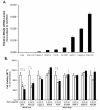Mesothelin confers pancreatic cancer cell resistance to TNF-α-induced apoptosis through Akt/PI3K/NF-κB activation and IL-6/Mcl-1 overexpression
- PMID: 21880146
- PMCID: PMC3175472
- DOI: 10.1186/1476-4598-10-106
Mesothelin confers pancreatic cancer cell resistance to TNF-α-induced apoptosis through Akt/PI3K/NF-κB activation and IL-6/Mcl-1 overexpression
Abstract
Background: Previous studies showed that mesothelin (MSLN) plays important roles in survival of pancreatic cancer (PC) cells under anchorage dependent/independent conditions as well as resistance to chemotherapy. The recent success of intratumorally-injected adeno-encoded, chemo/radiation-inducible-promoter driven hTNF-α, (TNFerade) + gemcitabine in pre-clinical models of PC have renewed interest in use of TNF-α as a therapeutic component. To help find additional factors which might affect the therapy, we examined the resistance of MSLN-overexpressing pancreatic cancer cell lines to TNF-α-induced growth inhibition/apoptosis.
Methods: Stable MSLN overexpressing MIA PaCa-2 cells (MIA-MSLN), stable MSLN-silenced AsPC-1 cells (AsPC-shMSLN) and other pancreatic cells (MIA-PaCa2, Panc 28, Capan-1, BxPC3, PL 45, Hs 766T, AsPC-1, Capan-2, Panc 48) were used. NF-κB activation was examined by western blots and luciferase reporter assay. TNF-α induced growth inhibition/apoptosis was measured by MTT, TUNEL assay and caspase activation. IL-6 was measured using luminex based assay.
Results: Compared to low endogenous MSLN-expressing MIA PaCa-2 and Panc 28 cells, high endogenous MSLN-expressing Capan-1, BxPC3, PL 45, Hs 766T, AsPC-1, Capan-2, Panc 48 cells were resistant to TNF-α induced growth inhibition. Stable MSLN overexpressing MIA-PaCa2 cells (MIA-MSLN) were resistant to TNF-α-induced apoptosis while stable MSLN-silenced AsPC1 cells (AsPC-shMSLN) were sensitive. Interestingly, TNF-α-treated MIA-MSLN cells showed increased cell cycle progression and cyclin A induction, both of which were reversed by caspase inhibition. We further found that MIA-MSLN cells showed increased expression of anti-apoptotic Bcl-XL and Mcl-1; deactivated (p-Ser75) BAD, and activated (p-Ser70) Bcl-2. Constitutively activated NF-κB and Akt were evident in MIA-MSLN cells that could be suppressed by MSLN siRNA with a resultant increase in sensitivity of TNF-α induced apoptosis. Blocking NF-κB using IKK inhibitor wedelolactone also increased sensitivity to TNF-α-mediated cytotoxicity with concomitant decrease in Mcl-1. Blocking Akt using PI3K inhibitor also had a likewise effect presumably affecting cell cycle. MIA-MSLN cells produced increased IL-6 and were increased furthermore by TNF-α treatment. SiRNA-silencing of IL-6 increased TNF-α sensitivity of MIA-MSLN cells.
Conclusions: Our study delineates a MSLN-Akt-NF-κB-IL-6-Mcl-1 survival axis that may be operative in PC cells, and might help cancer cells' survival in the highly inflammatory milieu evident in PC. Further, for the success of TNFerade + gemcitabine to be successful, we feel the simultaneous inhibition of components of this axis is also essential.
Figures







Similar articles
-
Mesothelin overexpression promotes autocrine IL-6/sIL-6R trans-signaling to stimulate pancreatic cancer cell proliferation.Carcinogenesis. 2011 Jul;32(7):1013-24. doi: 10.1093/carcin/bgr075. Epub 2011 Apr 23. Carcinogenesis. 2011. PMID: 21515913 Free PMC article.
-
Inhibition of nuclear factor kappaB and phosphatidylinositol 3-kinase/Akt is essential for massive hepatocyte apoptosis induced by tumor necrosis factor alpha in mice.Liver Int. 2003 Oct;23(5):386-96. doi: 10.1034/j.1478-3231.2003.00867.x. Liver Int. 2003. PMID: 14708901
-
Sphingosine kinase-1 enhances resistance to apoptosis through activation of PI3K/Akt/NF-κB pathway in human non-small cell lung cancer.Clin Cancer Res. 2011 Apr 1;17(7):1839-49. doi: 10.1158/1078-0432.CCR-10-0720. Epub 2011 Feb 15. Clin Cancer Res. 2011. PMID: 21325072
-
Emerging role of resveratrol in the treatment of severe acute pancreatitis.Front Biosci (Schol Ed). 2010 Jan 1;2(1):168-75. doi: 10.2741/s54. Front Biosci (Schol Ed). 2010. PMID: 20036937 Review.
-
PAR-4 as a possible new target for pancreatic cancer therapy.Expert Opin Ther Targets. 2010 Jun;14(6):611-20. doi: 10.1517/14728222.2010.487066. Expert Opin Ther Targets. 2010. PMID: 20426700 Free PMC article. Review.
Cited by
-
Mesothelin/mucin 16 signaling in activated portal fibroblasts regulates cholestatic liver fibrosis.J Clin Invest. 2017 Apr 3;127(4):1254-1270. doi: 10.1172/JCI88845. Epub 2017 Mar 13. J Clin Invest. 2017. PMID: 28287406 Free PMC article.
-
A novel PET imaging using ⁶⁴Cu-labeled monoclonal antibody against mesothelin commonly expressed on cancer cells.J Immunol Res. 2015;2015:268172. doi: 10.1155/2015/268172. Epub 2015 Mar 25. J Immunol Res. 2015. PMID: 25883990 Free PMC article.
-
Mesothelin expression correlates with elevated inhibitory immune activity in patients with colorectal cancer.Res Sq [Preprint]. 2023 Dec 28:rs.3.rs-3787873. doi: 10.21203/rs.3.rs-3787873/v1. Res Sq. 2023. Update in: Cancer Gene Ther. 2024 Oct;31(10):1547-1558. doi: 10.1038/s41417-024-00816-1. PMID: 38234761 Free PMC article. Updated. Preprint.
-
The Effect of Interleukin-6 (IL-6), Interleukin-11 (IL-11), Signal Transducer and Activator of Transcription 3 (STAT3), and AKT Signaling on Adipocyte Proliferation in a Rat Model of Polycystic Ovary Syndrome.Med Sci Monit. 2019 Sep 26;25:7218-7227. doi: 10.12659/MSM.916385. Med Sci Monit. 2019. PMID: 31554782 Free PMC article.
-
The dark side of immunotherapy: pancreatic cancer.Cancer Drug Resist. 2020 May 11;3(3):491-520. doi: 10.20517/cdr.2020.13. eCollection 2020. Cancer Drug Resist. 2020. PMID: 35582441 Free PMC article. Review.
References
Publication types
MeSH terms
Substances
Grants and funding
LinkOut - more resources
Full Text Sources
Other Literature Sources
Research Materials
Miscellaneous

